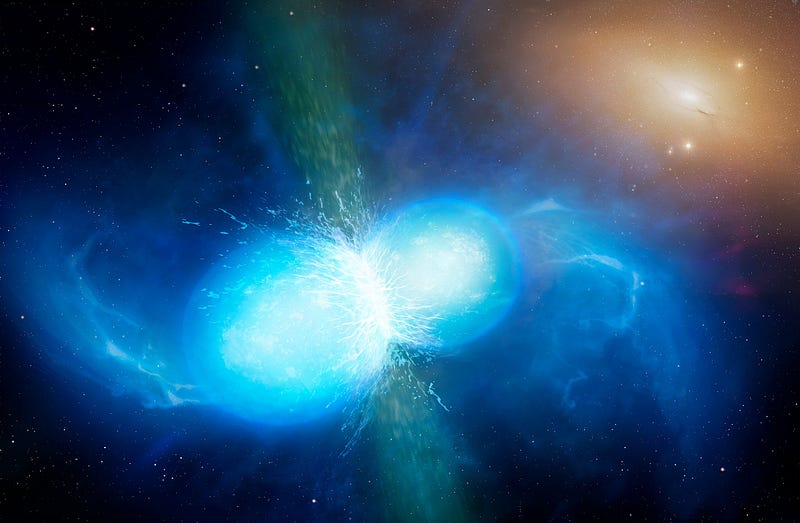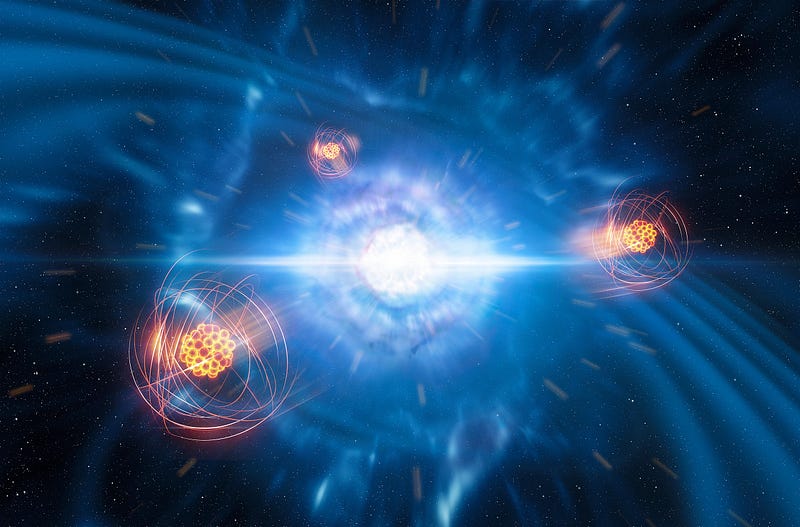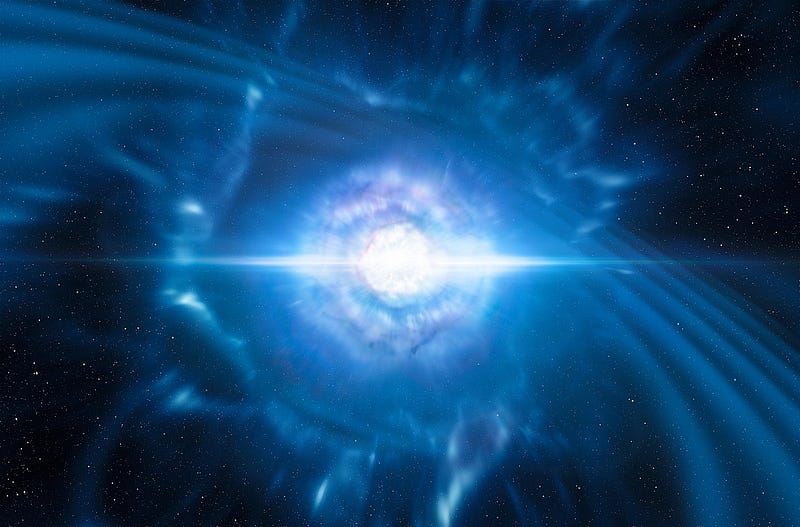A New Look at Neutron Star Collisions: The Kilonova Enigma
Written on
Chapter 1: The Cosmic Mystery of Kilonova Explosions
A recent enigma in astrophysics has emerged: why does the explosion resulting from neutron star mergers exhibit a near-perfect spherical shape? An analysis of kilonova data from 2017 revealed a surprising outcome. Instead of the anticipated asymmetry, the explosion was found to be remarkably symmetrical.

[Image: University of Warwick/Mark Garlick, CC BY 4.0, via Wikimedia Commons]
The collision of neutron stars represents one of the most awe-inspiring phenomena in the cosmos. Unlike many other cosmic events, this one has tangible impacts on our daily lives. For instance, the gold in our jewelry originates from these stellar explosions.
What is a Kilonova?
Imagine wearing a gold ring. Have you ever wondered how that gold was created? Gold, along with other heavy elements like platinum, was formed through cataclysmic events such as neutron star mergers. These celestial events produce heavy elements that eventually travel through space, contributing to the formation of our planet's crust.
Before these elements could reach Earth, a kilonova had to occur. This process involves two neutron stars drawing closer together, ultimately merging in a massive explosion that lasts mere milliseconds, leading to the creation of a black hole.
What Remains After a Kilonova?
A kilonova is a powerful explosion that can be observed using various astronomical instruments. The merging of these stars generates gravitational waves and gamma rays. The debris expelled into space emits X-rays, visible light, and radio waves, allowing for extensive study of these phenomena.
In 2017, gravitational wave detectors captured signals from the merger of two neutron stars, designated GW170817, located approximately 140 million light years away. This event was extensively observed by 70 telescopes, which monitored it across a broad spectrum of electromagnetic radiation, from gamma rays to radio waves, as noted by astronomer Paul Mudrin in his book "Universe: A Biography." The residual radiation lasted up to 2.5 years.

[Image: ESO/L. Calçada/M. Kornmesser, CC BY 4.0, via Wikimedia Commons]
The Perfectly Spherical Kilonova
Although the kilonova associated with GW170817 has been widely discussed, it remains a subject of ongoing research. A recent paper published in Nature by a team of astronomers revisited this explosion's data, uncovering findings that challenge established theories.
Albert Sneppen, a 24-year-old researcher from the Niels Bohr Institute and lead author of the study, explains, “You have two ultra-compact stars that orbit each other at incredible speeds before collapsing. Intuition and existing models would suggest that the resulting explosion should be asymmetrical.” However, the kilonova observed in 2017 contradicted these expectations, appearing almost perfectly round.
Why Was the Kilonova Round?
The spherical nature of this explosion presents a significant puzzle. Darach Watson from the University of Copenhagen, co-author of the study, states, “This likely indicates that our kilonova models have significant gaps regarding fundamental physics.”
So, what accounts for this round shape? For an explosion to be perfectly spherical, energy must escape uniformly from its core. Researchers propose that as the neutron stars merge into a giant neutron star before collapsing into a black hole, a powerful magnetic field may form, causing the ejected material to take on a spherical shape.

[Image: ESO/L. Calçada/M. Kornmesser, CC BY 4.0, via Wikimedia Commons]
Mysterious Element Distribution
Scientists have also recognized an inconsistency in their understanding of how heavy elements form during a kilonova. Current models suggest that the heaviest elements should be created in distinct regions of the explosion compared to lighter elements. Yet, only lighter elements were detected in the 2017 event, and they were evenly distributed throughout space. The reasons behind this anomaly remain unclear, but researchers speculate that neutrino emissions may play a role.
Chapter 2: Insights from Kilonova Research
The first video, "Neutron Star Mergers and the Origin of the Elements," delves into how these cosmic events contribute to the formation of elements we find on Earth.
The second video, "The Tale of a Neutron Star Collision," provides a narrative exploration of the fascinating processes involved in neutron star collisions.